23-Year-Old Hispanic Road Maintenance Worker Struck by Wheel that Separated from the Trailer Axle of a Tractor-Trailer Truck
New Jersey Case Report: 07NJ044
Report Date: March 13, 2009
Summary
On June 19, 2007, a 23-year-old male Hispanic public employee was killed when he was struck by a wheel and tire assembly that had separated from the axle of a flatbed pulled by a tractor-trailer truck. The victim was a laborer working on a road maintenance crew. On the day of the incident, the victim and one other worker were trimming grass with string trimmers on the southbound highway berm underneath an overpass, approximately six feet from a major New Jersey highway. A tractor-trailer truck was traveling in the southbound right lane of the highway when two tandem wheels separated from the rear axle of the trailer. One of the wheels struck the victim in the head, propelling him approximately 30 feet from the point of impact. The tire was found 43 feet south of the victim’s body, and approximately 73 feet from the point of impact. The second tire was found further south on the median of the highway. NJ FACE investigators recommend following these safety guidelines to prevent similar incidents:
- Employers of roadway work crews should assign a “spotter” to observe oncoming traffic; and workers should be trained to face oncoming traffic, whenever possible.
- A safety and health plan based on a job hazard analysis should be developed by the employer and followed for each highway work zone where workers are assigned tasks.
- State highway authorities should consider reducing speed limits in maintenance work zones on high-traffic highways.
Introduction
On June 19, 2007, a federal OSHA compliance officer notified NJ FACE staff of the death of a 23-year-old worker who was killed after being struck by a tire (with rim) that had separated from a passing tractor-trailer truck. A FACE investigator contacted the employer, and arranged to conduct an investigation, which took place on August 13, 2007. During the visit, the FACE investigator interviewed the immediate supervisor and colleagues of the deceased. Additional information was obtained from the medical examiner’s report and employer incident summary.
The victim was a public employee, and had worked as a laborer on the road maintenance crew of a government agency for approximately two years. One other road maintenance crew laborer was working at the site on the day of the incident. Employee health and safety training, as well as job training, was conducted by the employer and through the union.
Back to Top
Investigation
The incident occurred near a grassy area along the shoulder of the southbound side of a major highway in New Jersey. Two workers were assigned to trim the grass around poles and delineators. A truck with a rear-mounted attenuator (bump truck) was stationed approximately 25 feet north of the incident site (see Figure 1), a lead truck (cover truck) between the attenuator and the site (see Figure 2), as well as two advanced warning signs. While the workers were trimming grass, two rear tandem wheels separated from the axle of a flatbed trailer being pulled by a tractor- trailer truck traveling southbound on the highway adjacent to the incident site. One wheel rolled onto the center median. The other wheel rolled past the attenuator-equipped truck and struck the victim. The coworker witnessed the wheel rolling along the roadway and immediately radioed the victim, but received no response. The coworker walked back toward the incident scene and saw that the victim was lying on the ground. The worker called 911, and police and rescue workers arrived at the scene within minutes. The responders did not find any vital signs, and the victim was pronounced dead at the scene via telemetry.
According to the employer, the wheel and tire assemblies completely separated from the axle of the moving truck trailer because the lug nut studs sheared off from the wheel hub. Figures 3 and 4 show the wheel involved in the incident and the axle from which it separated, respectively. When the tire struck the victim, the victim was apparently thrown against an adjacent bridge abutment, landing approximately 30 feet from the initial point of impact with the wheel. Figure 5 shows an overview of the incident site.
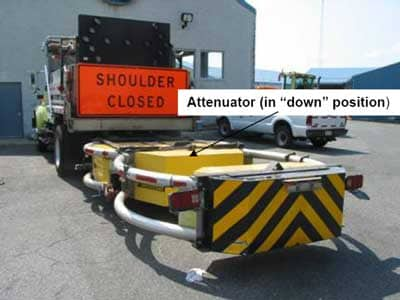
|
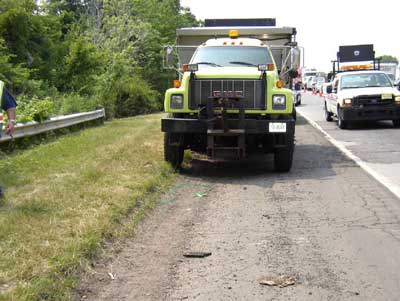
|
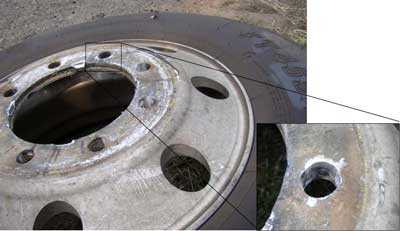
|
|
Figure 3: Wheel that was involved in the incident |
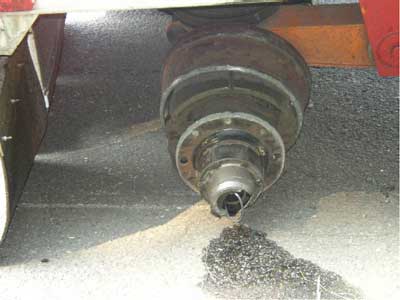
|
|
Figure 4: Axle of trailer from which the wheel separated |
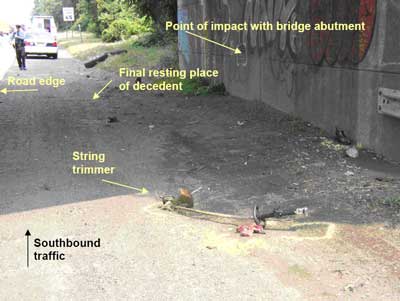
|
|
Figure 5: Overview of incident site
|
Back to Top
Recommendations/Discussion
Recommendation #1: Employers of roadway work crews should assign a “spotter” to observe oncoming traffic; and workers should be trained to face oncoming traffic whenever possible.
Discussion: A “spotter” assigned to observe oncoming traffic will be able to alert road crew workers of impending hazards, such as items that dislodge or fall from a passing vehicle and threaten to enter the work zone. Road crew workers that face the direction of oncoming traffic will have a better chance of reacting to any impending hazard originating from the flow of traffic in their direction.
Recommendation #2: A safety and health plan based on a job hazard analysis should be developed by the employer and followed for each highway work zone where workers are assigned tasks.
Discussion:
Employers should conduct a job hazard analysis, with the participation of employees, of all work areas and job tasks; although in this case, the hazard would have been difficult to foresee. A job hazard analysis should begin by reviewing the work activities for which the employee is responsible, and the equipment that is needed. Each task is further examined for mechanical, electrical, chemical, or any other hazard the worker may encounter. A source of information on conducting a job hazard analysis is included in the Appendix.
Recommendation #3: State highway authorities should consider reducing speed limits in maintenance work zones on high-traffic highways.
Discussion: Highway work zones are high-hazard areas. Many states, including New Jersey, have adopted policies for reducing posted speed limits in highway-construction work zones. Under normal circumstances, the Manual on Uniform Traffic Control Devices recommends that reduced speed zoning should be avoided as much as practical. However, in situations such as this, speed zone reductions may be warranted, as a lower speed may have prevented the tire from separating from the axle, or would have reduced the momentum with which the tire traveled. Highway-maintenance work zones should set speed limits based on the hazards present for both the motorists and the workers.
Appendix
Recommended Resources
It is essential that employers obtain accurate information on health, safety, and applicable OSHA standards. NJ FACE recommends the following sources of information which can help both employers and employees:
U.S. Department of Labor, Occupational Safety & Health Administration (OSHA)
Federal OSHA will provide information on safety and health standards on request. OSHA has four area offices in New Jersey that cover the following counties:
Hunterdon, Middlesex, Somerset, Union, and Warren counties
Telephone: (732) 750-3270
Essex, Hudson, Morris, and Sussex counties
Telephone: (973) 263-1003
Bergen and Passaic counties
Telephone: (201) 288-1700
Atlantic, Burlington, Cape May, Camden, Cumberland, Gloucester, Mercer, Monmouth, Ocean, and Salem counties
Telephone: (856) 757-5181
Federal OSHAexternal icon
Web site: https://www.osha.gov/
New Jersey Public Employees Occupational Safety and Health (PEOSH) Program
The PEOSH Act covers all NJ state, county, and municipal employees. Two state departments administer the act; the NJ Department of Labor and Workforce Development (NJDLWD), which investigates safety hazards, and the NJ Department of Health and Senior Services (NJDHSS), which investigates health hazards. PEOSH has information available that may also benefit private employers.
NJDLWD, Office of Public Employees Safetyexternal icon
Telephone: (609) 633-3896
Web site: http://lwd.dol.state.nj.us/lsse/employer/Public_Employees_OSH.html
NJDHSS, Public Employees Occupational Safety & Health Programexternal icon
Telephone: (609) 984-1863
Web site: http://www.nj.gov/health/peosh
On-site Consultation for Public Employersexternal icon
Telephone: (609) 984-1863(health) or (609) 633-2587(safety)
Web site: www.state.nj.us/health/eoh/peoshweb/peoshcon.htm
New Jersey Department of Labor and Workforce Development, Occupational Safety and Health On-Site Consultation Programexternal icon
This program provides free advice to private businesses on improving safety and health in the workplace and complying with OSHA standards.
Telephone: (609) 984-0785
Web site:
http://lwd.dol.state.nj.us/labor/lsse/employer/
Occupational_Safety_and_Health_Onsite_Consultation_Program.html
New Jersey State Safety Councilexternal icon
The NJ State Safety Council provides a variety of courses on work-related safety. There is a charge for the seminars.
Telephone: (908) 272-7712.
Web site: http://www.njsafety.org
Internet Resources
Other useful internet sites for occupational safety and health information:
- CDC/NIOSH – https://www.cdc.gov/niosh/
- Employment Laws Assistance for Workers and Small Businessesexternal icon – http://www.dol.gov/elaws/
- National Safety Councilexternal icon – http://www.nsc.org/Pages/Home.aspx (Link updated 8/14/2012)
- NJDHSS FACE reportsexternal icon – http://www.nj.gov/health/surv/face/index.shtml
- CDC/NIOSH FACE – https://www.cdc.gov/niosh/face/
Reference
Job Hazard Analysis. US Department of Labor Publication # OSHA-3071, 1998 (revised). USDOL, OSHA/OICA Publications, PO Box 37535, Washington DC 20013-7535.
New Jersey FACE Program
Fatality Assessment and Control Evaluation (FACE) Project
Investigation #07-NJ-044
Staff members of the New Jersey Department of Health and Senior Services, Occupational Health Service, perform FACE investigations when there is a report of a targeted work-related fatal injury. The goal of FACE is to prevent fatal work-related injuries by studying the work environment, the worker, the task, the tools the worker was using, the energy exchange resulting in the fatal injury, and the role of management in controlling how these factors interact. FACE gathers information from multiple sources that may include interviews of employers, workers, and other investigators; examination of the fatality site and related equipment; and reviewing OSHA, police, and medical examiner reports, employer safety procedures, and training plans. The FACE program does not determine fault or place blame on employers or individual workers. Findings are summarized in narrative investigation reports that include recommendations for preventing similar events. All names and other identifiers are removed from FACE reports and other data to protect the confidentiality of those who participate in the program.
NIOSH-funded state-based FACE Programs include: California, Iowa, Kentucky, Massachusetts, Michigan, New Jersey, New York, Oregon, and Washington. Please visit the NJ FACE websiteexternal icon at www.state.nj.us/health/eoh/survweb/face.htm or the CDC/NIOSH FACE website at www.cdc.gov/niosh/face for more information.
The NJ FACE Project is supported by Cooperative Agreement #1 U60 OH0345-01 from the Centers for Disease Control and Prevention (CDC). The contents of this report are solely the responsibility of the authors and do not necessarily represent the official views of the CDC.
To contact New Jersey State FACE program personnel regarding State-based FACE reports, please use information listed on the Contact Sheet on the NIOSH FACE web site. Please contact In-house FACE program personnel regarding In-house FACE reports and to gain assistance when State-FACE program personnel cannot be reached.

